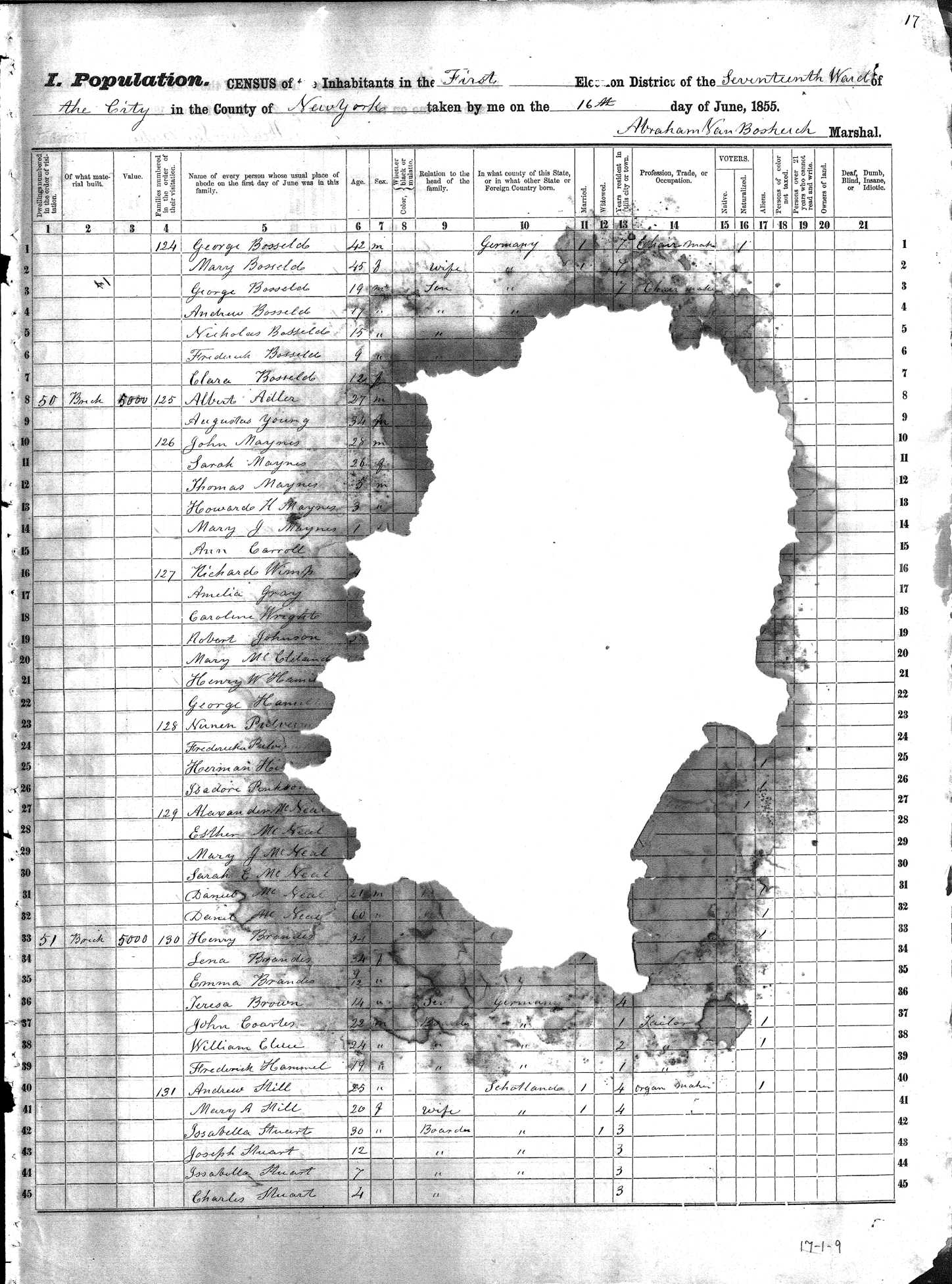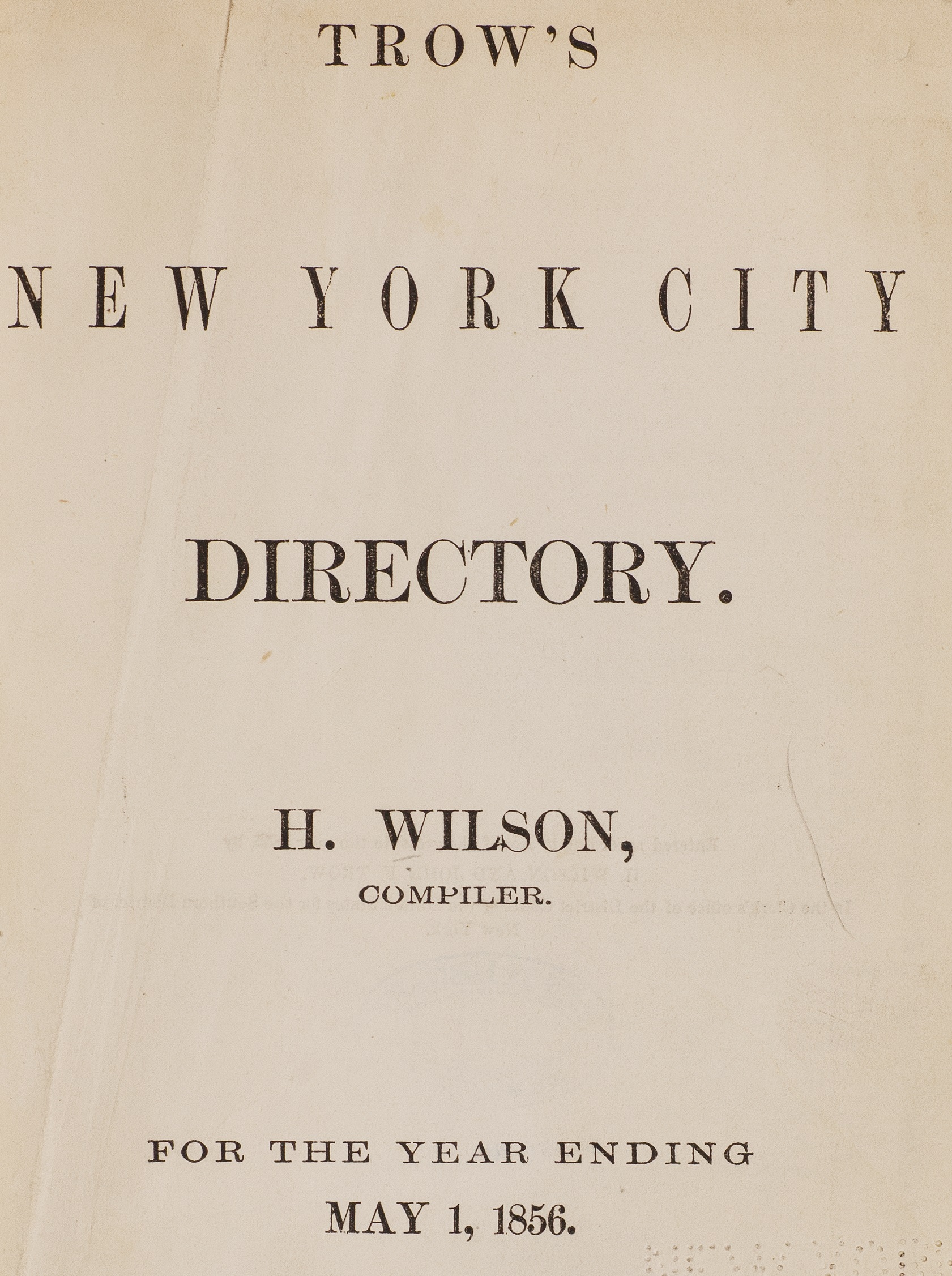The New York State 1855 census is a significant record set for family historians researching ancestors in New York State. Our eLibrary contains the only digitally available copy of the enumeration for one of the crucial immigrant neighborhoods of New York City, Ward 17.
These indexed images may hold information that leads to a major breakthrough for those researching nineteenth-century ancestors in New York County (Manhattan) - many factors distinguish the 1855 census as a unique record set among its peers, and Ward 17 itself is a very special location.
The information in this guide will be essential for anyone who would like to learn about the importance of this record set or attempt to search it for ancestors.
About Ward 17
Ward 17 itself is a very important neighborhood in the history of New York City. More than 60,000 individuals from the densely populated, largely immigrant community were enumerated in the 1855 census.
The area was bounded on the north by Fourteenth Street, on the east by Avenue B and a part of Clinton Street, on the south by Rivington Street, and on the west by the Bowery and a small part of Fourth Avenue, spanning what is today much of the East Village and the Lower East Side.
This part of the Lower East Side was often referred to as “Little Germany” - Ward 17 was the residential heart of this neighborhood.
According to our demographic analysis of the index, 62% of residents in Ward 17 were born outside of the U.S. - not surprising given that this geographical area has traditionally been a prime focus of immigrant arrivals and settlements.
But they weren't all Germans - in fact, there were just as many people born in Ireland as there were in the German region. Together, American, German and Irish-born made up just over (56%) of the total residents enumerated.
A wealth of other nationalities and ethnicities were also present in the neighborhoods - there were people whose national origin traced back to nearly every other country in Europe and the British Isles as well as a number of people of Carribbean, South American, and Asian origin - 39 different countries of birth in total. But by volume, the Germans, Irish and Americans dominated.
Read our blog for an interesting and useful breakdown of the demographics of Ward 17.
About the 1855 Census
The 1855 census is especially significant to family historians researching New York County (Manhattan) because it is the only surviving New York state census for that county until the 1905 census.
All other nineteenth-century New York state censuses for New York County have been lost. The rest of the 1855 state census can be found on FamilySearch, but the images are not indexed.
The 1855 census asked many genealogically pertinent questions, some of which the federal census would not ask until decades later.
This was the first state census to ask for all names and family relationships of persons enumerated with the head of household.
The relation to head of household is particularly important - this information allows for great certainty about the composition of the household, and helps an otherwise puzzled family historian determine whether the older female listed with their ancestor’s family is the mother, aunt, or mother-in-law of the head of household, or a border who is not related at all.
Another vitally important question that this census asked was “Years resident in this city or town.” This information is of great help in trying to ascertain when an immigrant may have arrived in New York City.

The census asked for the following information:
- Value and construction type of the property the family lived in, and whether the head of household owned the property
- Name
- Age
- Sex
- Race
- Relation to the head of the family
- Place of birth (county if born in NYS, state if born in US, country if foreign-born)
- Marital status
- Years resident in this city or town
- Occupration
- Voting eligibility
- Naturalization status

all pages in books two, three and four are fully intact!
Ward 17 enumerations are contained within four books, listing over 60,000 individuals, broken into ten different election districts. Unfortunately, the first book is badly damaged, and many of the pages of districts one and two of this census suffered water and insect damage.
Fortunately, these two districts were not totally residential; there was a strong industrial and commercial presence there, and these districts were physically smaller than many other districts, so fewer people lived within them.
And even though there is significant damage to many pages of districts one and two, there are still some names and other pertinent information that is readable on each damaged page.
The images of book one are available in the collection, but researchers should note that most names were not able to be indexed due to damage.
Originally, the Ward 17 books of the 1855 state census were not microfilmed with the rest of the New York State census material supplied by the New York County Clerk's office, due to its fragile and damaged condition.
The books were lent to the NYG&B in 2002 and scanned using the library’s digital image capturing equipment. NYG&B volunteers completed indexing the records in 2013.
This means the NYG&B eLibrary is the only place to find it, other than Division of Old Records of the New York County Clerk’s Office, where they are available for consultation exclusively in person.
Searching this record set
Searching the record set in the eLibrary is straightforward, and similar to other census searches - after entering a search query, the results will display all indexed entries returned, with a link to view the full image.
Not all of the above-mentioned information the census asked was indexed, so researchers are urged to view the original image.
Click here to view the Ward 17 1855 Census in the eLibrary
Name variants
Researchers should also note that, as with all censuses, the enumerator may have spelled names differently from the way in which the family spelled them.
Place names and occupations were also transcribed exactly as they were written, mistakes and all.
It is therefore useful to try looking under different surname variations. You may check the "name variants" box when performing your search, or research potential variations on your own.
The free website www.stevemorse.org has many resources on phonetic matching, including a quite sophisticated soundex code generator to help you find possible spelling variations.
Street addresses and locating families

1854 and 1855, because NYC directories often spanned
multiple calendar years.
One challenge presented by this state census is that no street names are recorded on its pages.
Fortunately, researchers can make use of city directory listings to find out exactly where a family may have lived at the time. The New York Public Library Digital Collections have many years worth of NYC city directories. Click here to go directly to the directory for 1855.
Important note: New York's city directories often spanned multiple calendar years, and not every neighborhood was captured at the same time. May 1 was a very common moving day for city residents, so guides often ended and began around this date. For this reason, you may want to also examine the city directory for 1854/55. Researchers should note that the 1855 state census was taken in June.
In general, it's a good practice to search city directories for a range of years around the time period you're investigating. The complete collection of NYC directories, which range from 1786 - 1923 (with many mid-ninteenth-century years included) can be found by clicking here.
Directories were taken once every year, so you may be able to find your family in many of these directories. Keep in mind, families moved often during this time period, so a thorough explanation of city directories can be very fruitful.
Volunteer Indexing Effort
After a monumental volunteer effort, the index of all four books of the 1855 New York state census for Ward 17 of Manhattan was completed in late 2013 and the transcription of the final book was added to the eLibrary in 2014.
The NYG&B is proud to be able to offer this resource to our members, and gratefully thanks the many hard-working volunteers who made this project a success:
- Dr. Stanton F. Biddle, project leader
- Ginny Arveson
- Maria Baker
- Terri Berio
- Judy Boehm
- Helen M. Boyden
- Ann S. Bradburd
- Darryl W. Bridson
- Loretta C. Brown-Aldrich
- Noreen A. Burns-McDonald
- Mary MacIvor Conway
- Mary Beth Craven
- Mary Deka
- MaryAnn Diederich
- Diane Drugge
- Joan Dunne
- Marilyn A. Fannon
- Eve Fowler
- Barbara Gentry
- Marita J. Gladson
- Kathleen Hendrickson
- Beverly Kane
- Phebe A. Kirkham
- Eugene Gerard Klein
- Charles A. Laverty
- J. Douglas Leith
- Barbara Lewis
- Julia G. Lovett
- Erica Lu
- Sarah MacDonald
- Maureen Mahon
- Chris Miasnik
- Valerie Mills
- William Ford Mitchell
- Mary E. Morabito
- Robert Newman
- Christy Newman
- Nancy Nispel
- Kathleen A. O’Farrell
- Robert A. O’Leary
- Terri B. O’Neill
- Wendy L. Oborne
- Beverly Peterson
- Nanette G. Pezzutti
- Sheryl Porter
- Alexander Perry Scott
- Francis W. Sloat
- Edward H. L. Smith III
- Dianne A. Snook
- Kathleen Tesluk
- Kathleen Trevena
- Suzanne Warnecke
- Catherine Weber
- Melanie Weiss
- Talia Weissman
- F. John Wilkes, Jr.
- Scott T. Zukowski
More Resources
-
Ward 17 Census, 1855 eLibrary Collection
-
The rest of the 1855 state census, available on FamilySearch (unindexed)
-
City Directories, 1786 - 1923, available at NYPL Digital Collections
-
Index to Ward 17, Manhattan, from the 1855 Census Is Completed (NY Researcher, Winter 2013/14)
-
Library Acquires NYC Ward 17 of the 1855 State Census (NYG&B Newsletter, Summer 2003)